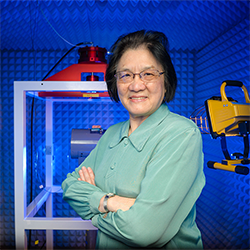AME’s Dr. Rong Gan was recognized by OU on International Women and Girls in STEM Day. The full article can be found below or through this link: https://ou.edu/web/research/women-in-science. Congratulations Dr. Gan!
Rong Zhu Gan is a Presidential Research Professor and the Charles E. Foster Chair in the Gallogly College of Engineering, Department of Aerospace and Mechanical Engineering. Her current research is supported by the Department of Defense and explores blast exposure hearing loss.
Supported by a $2.5 million DoD grant to understand blast-induced hearing loss by using biomedical measurement, her team developed the first 3D computational model to predict the blast wave transmission outside into the cochlear. A current grant extends that work to explore a cure for blast-induced hearing loss by using a leading diabetes drug that has the potential to recovery sensory auditory damage.
Gan has two patents currently under review, adding to two previous patent awards. One of the patents being reviewed is for use of the diabetes drug to treat trauma-induced hearing loss; the other is for mid-ear reconstruction using a 3D printer that can print soft and hard tissue.

She said she likes the challenge of studying hearing and her work has made others take notice, including being asked to serve on the DoD’s Congressionally Directed Medical Research Programs. The CDMRP aims to advance medical and scientific research and fill research gaps by funding high-impact, high-risk and high-gain projects that other agencies may not venture to fund.
“Hearing is a challenge,” Gan said. “Also hearing is more close to the patient, to the benefit of society. It is not the pure, basic research. We are close to real society…I am very honored to be a part of the CDMRP panel to determine this funding.”
Gan’s research success is made all the more impressive by the perseverance that presided it.
Born in Wuhan, China, Gan’s educational opportunities were limited during the Cultural Revolution in China. She trained as a mechanical engineer and worked at a car manufacturing company from 1968 to 1978. With the end of the Cultural Revolution, she went back to school to pursue a graduate education, changing her area of study from mechanical engineering to biomechanics.
“In 1978, I met the father of biomechanics or biomedical engineering, YC Fung from the U.S., when he visited Huazhong University of Science and Technology,” she said. “Since then, I was YC Fung’s student.”
Yuan-Cheng “Bert” Fung was an American bioengineer, regarded as a founding figure of bioengineering, tissue engineering, and the “Founder of Modern Biomechanics.”
In 1983, Fung hosted the first U.S., China and Japan biomechanics conference at the Huazhong University of Science and Technology in Wuhan. Gan was a master’s student at the time and reported her first scientific paper during that meeting.
She wanted to study with Fung in his lab at U.C. San Diego, but didn’t have the English language skills to pass the entrance exam. Instead, she used Russian as her foreign language to complete a master’s degree in mathematics at the University of Alberta Edmonton, Canada.
Fung and Gan crossed paths again in 1988 at a conference in Ottawa, where he introduced her to his former student, Michael Yen, who had started a biomedical engineering program at the University of Memphis. Gan completed her doctorate in biomedical engineering from the University of Memphis in 1992.
“My Ph.D. is in pulmonary blood flow in the lung biomechanics,” she said. “That was YC Fung’s direction. Later on, after my short postdoctoral period in New Mexico, I came to Oklahoma in 1995, totally changing my direction into hearing and the auditory system. I came to Oklahoma to be the director for hearing implantable devices at the Hough Ear Institute.”
Gan helped gain the institute’s first FDA-approved mid-ear implantable device.
In 1998, OU received a Special Opportunity Award to develop a biomedical engineering program, the first program of its kind in the region. Gan became the first biomedical engineering faculty member at OU. It began as a graduate program in 2003 and expanded to an undergraduate degree in 2016.
“You can see in my training how broad my background was. YC Fung is my mentor,” Gan said. “He introduced me to these new fields, biomechanics and biomedical engineering. He was the first advisory board member for (OU’s) biomedical engineering.”
Gan now pays that mentorship forward with students in her own lab.
“I always get very good students from the biomedical engineering department, and I love to teach and to mentor students,” she said. “In any lab, if you want to be successful, you must look for new direction. No matter your skin color or where you come from, you have to work hard. You must build your motivation for the science…you love the discussion, the discovery, to solve the unknown questions. I believe motivation is very important and finding a good mentor.”
She adds that a good professor is responsible for providing guidance to show students what is important, but a student’s success depends on their own motivation.
“Any success depends on yourself,” she said. “No matter what environment, persevere, work hard. If you really want to jump into science and technology, you need to have experience.”